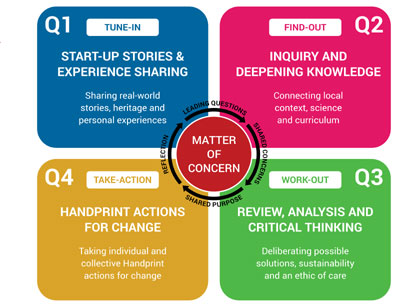Resources for the inclusion of ESD in school subjects
This Handprint CARE educational resource section has a set of exemplars on common environment and sustainability topics. Exemplars are models which are designed to support and promote the application of theory into practice. All of the materials and activities suggested are intended to provide illustrative starting points for teacher education. These are developed around real-life start-up stories that invite learners to share their own stories and experiences and to raise questions for learner-led inquiry, evaluative deliberation and action. Here learners work as individuals and through evaluative actions as part of social movements deliberating futures that will sustain humanity at a time of the current COVID-19 pandemic, accelerating biodiversity loss and emerging climate change.
Each exemplar has been designed following four quadrant schema which has been introduced in chapter 3. These quadrants could be followed in any order by the teacher based on the learner’s level of understanding and local environment. The exemplar begin with real-world stories from different countries across the globe. Teachers may introduce these stories and facts that are related to the concept and also encourage students to share their experiences. These stories will help students to understand different perspectives of the issues in hand. Following the start-up stories are various activities given to students to undertake local-inquiry work. These activities include solving eco-puzzles, conducting surveys/interviews in their immediate surroundings, going on a field visit, etc.
 Teachers can modify these tasks and include additional information based on the age and grade of the students. Following this is the design challenge where students review, analyse and design sustainable solutions. Finally, the students are given an opportunity to apply their learning, understanding practical ground realities and take Handprint actions.
Teachers can modify these tasks and include additional information based on the age and grade of the students. Following this is the design challenge where students review, analyse and design sustainable solutions. Finally, the students are given an opportunity to apply their learning, understanding practical ground realities and take Handprint actions.
The suggested quadrant model (from Q1 to Q4) is one of the many ways to drive learning. But teachers may come across other possibilities of using this quadrant schema where they can start from any quadrant. For example: Students can attend a beach-clean up (Q4) and with this Handprint action proceed to other quadrants. Hence, teachers can modify the flow of the quadrants based on the requirements of the classroom and learners needs.
These exemplars are just starting points for teachers to begin conversations/discussions in classrooms about a particular topic. To further enhance classroom discussions around that topic, teachers can include other point of views and interesting real-life stories (local or global) at the learners’ level (age and grade appropriate). These can be also shared with other teachers from your schools/other schools and collaborate as a community to start thinking and taking Handprint actions for the common good.